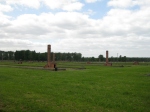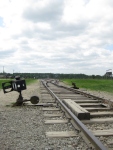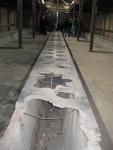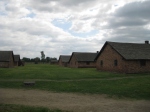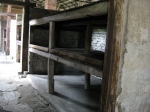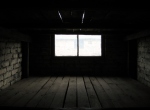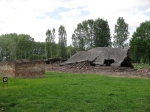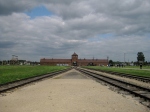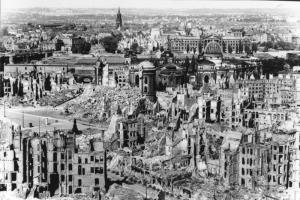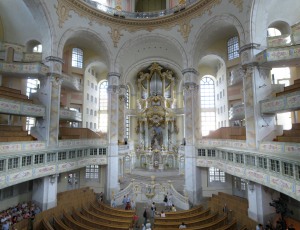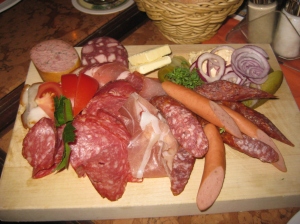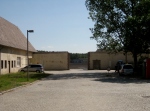Post-thesis update

This work is licensed under a Creative Commons Attribution-NonCommercial-NoDerivs 3.0 Unported License.
I find it surprising and sometimes a little unbelievable that I turned in my thesis and graduated six weeks ago. In that time I managed to start my graduate program with a study tour to Germany and Poland to visit various Holocaust, World War II, and communist occupied sites. I also spent a good deal of money on German and Polish cuisine (my idea of a souvenir), managed to gain a few pounds, bought a few things here and there, and returned home to the gym awaiting me and my lovely acquired five pounds of pierogies and salami pudge. It could have been worse. It could have.
My thesis ended up being 68 pages and a piece of work I was ultimately very happy with. When it got down to the wire, the pressure hit hard and I felt my editing skills fall to the way side a little. In general, it was a 98% piece of art and I am extremely proud of my college for having put together such a stellar program that gives its students a chance to essentially write at a Masters level. The final title was “The Battle of Vienna 1683: Proto-Orientalist Entanglement Between Two Empires”. If that doesn’t sound intelligent, I don’t know what does.
You might be wondering or asking the person next to you, what does that mean? I’ll tell you. It means you need focus your attention up and away from the ground. That’s how I like to look at it. A battle is fought on the earth, with names, dates, and facts kept in the concrete. I like to shift my attention upwards, so to speak, at the clouds. I imagine history as something conceptual– everything starts from something that preceded it. Before Said’s iconic research on the orientalist movement, there had to be something that kickstart the way people were thinking. I defined that as proto-orientalism. I consider this word my own, and when my thesis gets published YOU BETTER CITE MY THESIS IF YOU PLAN ON USING THE WORD PROTO-ORIENTALISM BECAUSE YOU AIN’T GONNA FIND THAT ANYWHERE ELSE. But really. It’s my concept, and all the writing I did was based off my own brain. The works I used came from primary sources and secondary sources, but they all focused on concepts and movements in history (as well as some of that factual stuff). It was through these works that I realized the documents I was reading were revealing to me the very thing that eventually led orientalists to treat their subject as they did. Got it? I sure hope so (getting sweaty palms trying to remember all this stuff as I write it so many weeks later).
I’m including a quote that I absolutely love– not because I agree with what it says (I don’t agree with any of it actually), but because it encapsulates perfectly what I thought proto-orientalism came to be:
If the superstition, vanity and ill foundation of the Mahometan Religion seem fabulous, as a Dream, or the fancies of a distracted and wild Brain, thank God that thou wert born a Christian, and within the Pale of an Holy and an Orthodox Church. If the Tyranny, Oppression and Cruelty of that State, wherein Reason stands in no competition with the Pride and Lust of an unreasonable Minister, seem strange to thy Liberty and Happiness, thank God that you art born in a Countrey the most free and just in all the World.♦
Here’s my own reasoning that’s somewhere in my thesis (and if you try to use this oh boy you better believe I’ll come after you): “Here (in quotes) he implied that Islam was a whirlwind of heretical scripture and a fantasy of moral conduct, far inferior to that of Christianity. And above all, he encapsulated the Western sentiment that it was better to live in the West where they were free, than to live in the chaos of the East. As we shall see, the negative implications of Ottoman influence on the Habsburgs, Christianity, and the West mirror the socio-religious norms of the Ottomans, Islam, and the East. The opinions formed by European Christians prior to the start of the nineteenth century are what ignite the subsequent Orientalist study of the East; that the lifestyles, religious practices, and laws signify inferiority to those in the West.”
I just laughed out loud, I can’t believe I wrote that. Curious Historian, you can give yourself a pat on the back tonight.
♦ Paul Rycaut, The History of the Present State of the Ottoman Empire, Containing The Maxims of the Turkish Polity, the most Material Points of the Mahometan Religious, their Sects and Heresies, their Convents and Religous Votaries. Their Military Discipline, with an Exact Computation of their Forces both by Sea and Land (London: Unknown publisher, 1686), xiii. http://hdl.handle.net/2027/mdp.39015073729850
Study Tour Extra: Food Review

This work is licensed under a Creative Commons Attribution-NonCommercial-NoDerivs 3.0 Unported License.
The following is a review I wrote and submitted for my college’s daily travel blog. I thought I would post it on here if anyone was interested in a somewhat witty and somewhat charming review of the food (as if I haven’t mentioned it enough already!):
———————-
From May 9th to May 22nd the Holocaust & Genocide Study Tour participants dined in all places from local favorites to world class restaurants. The class began its delectable culinary exploration in Berlin, where German treats such as bretze and bratwurst were among the first to be purchased by hungry students. For some students new to Europe, traditional German food such as sauerkraut and spätzle were received with two thumbs up. Schnitzel was also enjoyed by everyone on the trip. The group arrived at the perfect time with the beginning of spargel season, which is a white asparagus served plain, with breadcrumbs, or a delicious hollandaise sauce. Everywhere one went in Germany, advertisements for the popular asparagus dish were present.
On the last evening in Berlin, the study tour and esteemed guests dined and celebrated the first half of the trip’s success at a Berlin favorite called St. George’s Pub. Everyone was served a mouthwatering three course meal consisting of salad, a main course of meat, fish, or vegetarian option, as well as a fabulous dessert. Many students felt that this night was one of the highlights of the trip.
It should also be noted that throughout the tour of Germany when students had the option to purchase food during a break, the adventurous tried the wildly popular döner, a Turkish kebab of juicy lamb or chicken served with tatziki sauce and fresh greens. Turkish food has found its way in German culture and has become a symbol of not only the culinary scene, but a historical coming together of two cultures as well.
In Poland most students were eager to get their hands on pierogies, a typical American thought of Polish cuisine. And delicious they were! The pierogies were always fresh and served with cheese and potato, meat, or sauerkraut and mushrooms. Most students opted to eat pierogies whenever they could!
In the last days of the trip, students and guides met for a truly inspirational dinner with a Righteous Gentile. The Radio Café served a delicious array of Polish food including rolled steak with buckwheat kasha (a new experience for many) or stuffed cabbage. When dessert was served, Marian Golebiowski and his daughter recounted the days when Marian realized his life had changed in an instant. It was a moving experience which left students empowered with kind words of love, compassion, and understanding for others.
I speak for many when I say that the students were sad to leave Europe. Both the historical and cultural experiences were enjoyed by everyone and food was an important part of the experience. We leave Europe with filled stomachs and open minds for perhaps recreating delicious recipes back in America!
Day 10 (Warsaw)

This work is licensed under a Creative Commons Attribution-NonCommercial-NoDerivs 3.0 Unported License.
Just as the other days had unfolded, Warsaw too would be conquered with our footsteps. The group prepared for another walk through Warsaw to visit memorials designating areas of significance during the Warsaw Ghetto.
Even as an early adolescent I remember wanting to visit Warsaw to see and learn about the ghetto. In middle school the words ‘Warsaw’ and ‘ghetto’ were synonymous thanks to our Holocaust education. With the exception of one museum, I was disappointed with what I saw. The memorials dedicated to different parts of the ghetto perimeter were unoriginal and insignificant. We stood on the sidewalk and gazed upward to look at a series of cables connecting either side of the street. This signified the old bridge that intersected Warsaw and the ghetto walls. Below us, the concrete indicated the partition of the wall. The partition was no different than in Berlin and I was unimpressed by the unoriginal thought.
There was one square in the city where perhaps a hundred stylized high chairs were secured to the ground. These chairs were symbolic of the victims of the ghetto. I found this memorial to be interesting but unfortunately I do not have a picture of it.
Our group walked to an unassuming apartment complex and stood in the courtyard  waiting to hear from our tour guide. As it turns out the complex was once the stage for a horribly violent uprising. It was surprising to think we were standing in a place that was at one time littered with bodies and gore. I suppose this was more of a surprise because of the complex’s unassuming nature (as opposed to Ravensbrück, Auschwitz, or Berlin).
waiting to hear from our tour guide. As it turns out the complex was once the stage for a horribly violent uprising. It was surprising to think we were standing in a place that was at one time littered with bodies and gore. I suppose this was more of a surprise because of the complex’s unassuming nature (as opposed to Ravensbrück, Auschwitz, or Berlin).
A few paces further ahead and around the corner was an actual section of the ghetto wall still intact. Even the concrete was uneven to delineate where the ghetto used to be. Unlike the Berlin Wall this was not graffitied by its inhabitants. A few blocks away there was another portion of the wall still up and unfortunately this site was the target of anti-Semitic graffiti in June (more about that here).
Our tour moved on to look at a memorial dedicated to Polish Jews who were victims of the Holocaust (especially at Auschwitz). The memorial seemed almost like a mausoleum in its design, although I do not know if this was intentional. Behind it a new museum is being built that will be about Warsavian Jews pre-, during-, and post- Holocaust. The figures on the memorial seemed to cry out in agony, wondering why they had been subject to such a fate.
We were so fortunate to be surprised with a special guest at our dinner that night at the Radio City Cafe in Warsaw. Marian Gołębiowski was a wonderful man who saved the lives of two Polish Jews during World War II (look him up here). He was in love with a girl who was in love with another man. He did not know this until the woman had come to Mr. Gołębiowski for help. At such a young age and with a life ahead of him, Mr. was now looking at a life and death situation. Thinking selflessly, he agreed without hesitation to help and the two survived the Holocaust.
Mr. Gołębiowski’s story was inspiring. With such a bright character and passionate speech, it was impossible not to be awestruck. It’s not everyday you have dinner with someone who is attributed with such a high honor. Grateful of his earned title, he wanted to leave us with one last speech: that the people of this Earth should never call concentration camps Polish death camps. He was so passionate he began to cry about how upsetting it was that some people still refer to Auschwitz, Majdanek, and other places as Polish camps. Mr. Gołębiowski wanted us to remember the Nazis came into Poland and occupied Polish land– it was entirely of their doing and althought it was terrible, it should be remembered only in that way.
Ironically enough, a few weeks after I returned President Obama made some sort of reference to a Polish death camp on a televised speech. Whether it was he or an intern who wrote that speech, I cannot imagine how upset Mr. Gołębiowski was at hearing that preposterous statement.
Day 9 (Kielce)

This work is licensed under a Creative Commons Attribution-NonCommercial-NoDerivs 3.0 Unported License.
After Auschwitz, I think it can be said that our attitudes changed. We had seen the very worst of what was in the world and it’s hard to rise from that. When we went to Kielce for our next day of walking, we took interest in the history but there was hardly any real physical connection to the past.
Our tour guide, a real expert in the field, showed us various sites of memory from the Holocaust and the pogroms that arose after the Jews returned to their homes. It was hot and sunny and it was hard to take in information when the only things we could look at were slabs of stone with words etched in them.
We visited a cemetery a few minutes away from the town of Kielce that had been bombed during the war causing the tombstones to scatter and lose their places of rest. Since it remained unclear where they were supposed to be returned, the townspeople placed the tombstones that endured the bombing in a sort of pyramid, with each level ascending containing less tombstones than the previous level. Even though not everyone’s epitaph is represented, the idea is to express that anyone whose final resting place is in this cemetery is honored and represented collectively. I should add that some of these headstones were from several centuries ago.
The cemetery also had a separate memorial for children who were victims of the Kielce Cemetery Massacre which happened on May 23rd, 1943. You may notice the date of this tragic event is more toward the latter half of the war– these children had survived the Kielce Ghetto and concentration camps. The Nazis dug a pit, shot the children into the pit, and covered it up. The youngest child who was executed on this very spot where the memorial stands was only a few months old. The oldest child was fifteen. Years later, families of the victims who had survived created a space with a plaque and many Stars of David. The rocks on the memorial are in lieu of flowers– it is a tradition found in the Middle East (Muslims do it too). Flowers last for awhile but a rock will sit there forever.
The last memorial we saw in the cemetery was of a lengthy slab of granite with a broken Star of David seen in the middle. It represents that the Jews were broken during the Holocaust.
We headed back onto the bus and into the town of Kielce where we looked at three more memorial sites. The first was a huge menorah that rests above the remains of people who died during the Kielce pogrom. After the Jews returned home from their liberation, life was not easy. One of the largest pogroms in Poland happened in Kielce and overy forty people were killed during the fight. A friend on the tour noticed the stickers that had been tagged on the menorah and he asked the tour guide about it. Whatever it was that the sticker said, our tour guide was very surprised– he said it was a derogatory expression about Jews and that if the criminal had been seen tagging the menorah he could have gone to jail. I thought that was interesting (and sad that someone would deface a memorial).
We walked a ways down the street where we came to another memorial, although it was rather unsightly and confusing. The artist intended it to represent the Kielce Pogrom but I can’t wrap my head around it, and from what our tour guide told us, the townspeople don’t like it either. What do you think it means, knowing that it represents the event in which 45 Jews were killed?
We were all due for a lunch break after our blustery hot walking tour. The area we had been walking around in was nothing special, but we turned down two streets and it was like we were in a totally different place! The main street of Kielce is absolutely love, a charming street with beautiful brightly colored buildings, wrought iron fences, and lovely shops. How wonderful it was to take our rest here! We ate at a fantastic restaurant and had ice cream that was just as good afterward. I would love to come to Kielce just to be on that street again!
Day 7 Cont’d (Auschwitz-Birkenau)

This work is licensed under a Creative Commons Attribution-NonCommercial-NoDerivs 3.0 Unported License.
For the post about Auschwitz I, please click here.
We left the infamous gas chamber / crematorium in KZ-Auschwitz and walked together back to the camp’s entrance not saying a word to one another. Each person had the same expressionless face as they either contemplated what they had just seen or couldn’t process anything because it didn’t seem possible. So much weighs on so few steps in and out of a building. But here stepping outside bears the weight of the would be’s, could be’s, and should-have-been of a myriad of people.
Eventually we left KZ-Auschwitz by bus and drove to Auschwitz-II, or Auschwitz-Birkenau. Our professors said that in the past their study tours walked from camp I to camp II, which is quite a lengthy walk. Although I do not know how long the bus ride lasted, it was long enough to affirm that walking would have taken up a lot of time. It made me also want to walk since no prisoner ever had the luxury of taking a bus, but for brevity’s sake, on we drove.
Our arrival at Auschwitz-Birkenau was again ripe with anticipation. Although every camp is a nightmare, Birkenau seems to be the icon of the Holocaust; more recognized (at least in name) than any other camp. My first impression of the place was that it was desolate in a different way from KZ-Auschwitz. Most of the buildings were destroyed during the bombing and what was left were stacks of bricks indicating where a barrack once stood. It gave an eery vibe seeing bricks rise into the air on a shaky foundation. Once again there was grass everywhere mixed with dust that rose up with each step. Had there been no grass today just as during the Holocaust, I’m not sure this place would have been bearable. The camp seemed to ache as it bore the burden of its hell for years and years.
We entered the few barracks that were still standing and stood dumbfounded looking at the living conditions. These people were treated as less than animals. What was originally supposed to be a horse stable was converted into a space where hundreds of people were crammed with no proper place to sleep, eat, rest, or even urinate. The Nazis made no attempt to cover up the stable’s intended use, as the tying rings for horses were still evident on the sides of the wall. Where there were wooden bunks, people were forced to sleep with as many as four others in a bunk, possibly more. The “latrines” in the next building were nothing more than holes cut out in rock with a collection point for sewage that was almost never collected. Prisoners were essentially forced to live in their own waste and often people died from disease in the camps.
We walked down the same dusty road alongside the train tracks that the newly arrived prisoners were made to stand on, ultimately being placed to the left or the right. The notorious SS doctor Josef Mengele separated people with a casual wave of the hand whereby people could be sent straight to their deaths. And he did it “carefully”! I felt rooted to the spot and listened to nothing as I stood there. People begged, pleaded, and bribed officials not to be separated from their family. And unbeknownst to the victims sometimes their pleading actually landed them in the group sent straight for the gas chambers.
The group continued around back of the camp to look at more barracks that were preserved. In these barracks the “beds” were made of bricks. The bricks were haphazardly put together and sometimes the weight of people above would cause the bricks to break crushing the people below. It was a sick sight to look into a brick bunk knowing thousands of people slept there and died there.
From the rear barracks we made our way to the sites of former gas chambers and crematoriums, all in ruin. Flowers and rocks were placed around the edges of the site honoring those who had been murdered. Originally the gas chambers were below ground level but because of the destruction we could look into them. How terrible it was for those prisoners to have to march all the way to the back of the camp and be told they were there to get a shower while smelling that awful smell from the crematorium.
On our last stop we visited the in-processing building housed way in the back of the camp. Here the prisoners who passed selection were given a cold shower and a hair cut (hair was shaved on women too). They also received a set of clothes, albeit from the prisoners who had died before them. If by chance a “defect” was found by the Nazis while in-processing, that person would be taken from the line and killed. Examples: a possible wound, a hidden pregnancy, a physical defect, etc).
It was ironic to have our last stop on the tour be the place where prisoners would first go for their doomed sentence. The walk to the entrance was probably a mile away and along the path back the group reflected over the day’s events. I do not see myself going back to Auschwitz again but I think everyone needs to visit. I have not given that much of a written description of Auschwitz I and II for a reason– because it simply does not have much for me to say. What can I say to do it justice? What can I say that conveys an event in history that is the most horrifying of mankind? I feel like a person of few words when I think about Auschwitz, but I think that is okay.
There is a real lesson to be learned here, especially for the people who still believe antisemitism is right or deny that the Holocaust happened. Auschwitz-Birkenau is a harrowing place. 1.2 million people were murdered on these grounds because they were unfit for society according to Nazi standards. As human beings, we never should have let that happen. And today, we should never let ourselves forget what happened. Walking around Auschwitz I and II is disturbing but almost necessary to carry on the stories of those who struggled, who survived, who passed. We have an obligation to never forget what happened and to never let it repeat itself. Unfortunately, our world is not perfect. We still have genocide and we still have repressive governments that continue to starve their own people, rape their women, and kill because their religion is “wrong.” We need difference in this world, we need diversity. Just because you are Jewish, a Jehovah’s Witness, handicapped, gay or lesbian, Eastern European, or whatever for that matter, does not mean that you are unfit to live in any society. Respect one another’s differences and learn from it. Do it for the 17 million people who wanted freedom, acceptance, and to be loved and never got it.
- Barrack remnants
- SS selection ground
Hovering over an image will allow you to see a description of what it is.
Day 7 (Auschwitz)

This work is licensed under a Creative Commons Attribution-NonCommercial-NoDerivs 3.0 Unported License.
The visit to Auschwitz and Auschwitz-Birkenau was one of the definitive points of our study tour. It’s what we signed up for when we decided to we wanted to do this trip. It’s what we knew would have the greatest impact on us while we were there. It’s what we knew would change our lives after we left.
The night before we visited Auschwitz I could not sleep. It was the same with Ravensbrück, the female concentration camp in Germany that we had visited a few days before. How can one sleep before they visit the very place that maimed, tortured, destroyed, and killed 1.2 million people? How can one eat? My time up to and including the bus ride there was ripe with anticipation.
As I sat on the bus I looked for the sign to Oświęcim, the Polish word for the town of Auschwitz. As always, the countryside was beautiful– too beautiful as a way to cover up where victims of the Holocaust were really headed. We entered the town of Auschwitz and drove past many factories. It made me wonder how the townspeople feel. What is it like to live in this town? (Addendum: A good article can be found here about it).
We drove past the factories and in a very surreal way, I knew it meant we had come close to the camps. Things turned grey– the roads, the ground, the buildings looked strange and twisted. And that’s when we passed brick buildings surrounded by a barbed wire fence. We pulled into Auschwitz and the grey mixed with an ugly sand color that had lost its saturation.
After we received headsets (group tours can wear headsets to listen to their tour guide while being able to walk around individually) we stood outside in the area before the infamous Auschwitz I gate. Our tour guide was quiet but informative. Normally I took notes each day, but I knew I would take no notes here. What could I jot down? Auschwitz was a visual, audible, tactile, and olfactory experience. Everything I learned that day was through the senses.
 Even though we collectively walked under the gate, I felt like I had passed through it alone. The phrase Arbeit Macht Frei means “work sets you free”– that alone can be interpreted in a number of ways. Perhaps holding on to hope and waiting to be freed made people feel isolated as they realized it wouldn’t happen. That’s certainly how I felt.
Even though we collectively walked under the gate, I felt like I had passed through it alone. The phrase Arbeit Macht Frei means “work sets you free”– that alone can be interpreted in a number of ways. Perhaps holding on to hope and waiting to be freed made people feel isolated as they realized it wouldn’t happen. That’s certainly how I felt.
We toured through some of the buildings which housed exhibitions about the kinds of people who were sent to Auschwitz. Gypsies, Jehovah’s Witnesses, “asocials” (criminals, homosexuals, mentally ill), political resisters all succumbed to the same fate. The Eastern European Jews however were murdered as quickly as possible.
Life in the camps was horrendous. Today there are trees and grass lining parts of the camp. This was not the case during the Holocaust. Green meant edible, and for people who received hardly any rations, this could have been food. This is one of the misleading elements about the site today. In the two camps we visited grass was everywhere. More about that later though.
The world-famous collection of artifacts from Auschwitz is ironically enough housed in one of the former barracks (I was not aware of this prior to visiting). We walked into a room with dozens of Zyklon-B canisters that were used to murder the prisoners. The sight of these cans brought up an anger in me. It’s been recorded that there were SS-guards and Nazi officials who got nauseous looking into the peep holes to watch the prisoners die. There are also reports of the same types of people who enjoyed watching innocent people die and wanted to expedite the process to kill even more people in one day. Who among these two groups is worse, is crazier? Those that can’t stand the sight of it and acknowledge it’s grotesque nature but allow it to continue, or those who don’t?
one of the former barracks (I was not aware of this prior to visiting). We walked into a room with dozens of Zyklon-B canisters that were used to murder the prisoners. The sight of these cans brought up an anger in me. It’s been recorded that there were SS-guards and Nazi officials who got nauseous looking into the peep holes to watch the prisoners die. There are also reports of the same types of people who enjoyed watching innocent people die and wanted to expedite the process to kill even more people in one day. Who among these two groups is worse, is crazier? Those that can’t stand the sight of it and acknowledge it’s grotesque nature but allow it to continue, or those who don’t?
We walked up the stairs into one of the most famous of rooms, the collection of prisoner hair on display. Anger was replaced with complete and utter sorrow. When you see how much hair is still there, it’s unbelievable. Replicate that to the amount of 1.2 million and it would be downright deranged. I myself felt uneasy in my body knowing that I could look at shorn hair but the people to whom that hair belonged could never have a choice. Out of respect for the dead, photographs were not permitted in the room.
The next rooms contained eyeglasses, prayer shawls, personal effects (bowls, combs, etc). We saw only a fragment of what the Nazis collected– again a surreal and uneasy experience. Our emotions were stirred once again as we were in the rooms that held prosthetic devices, canes, crutches, and other support devices. The people who needed physical assistance were always separated and sent straight to the gas chambers. The Nazis deemed them unfit for work and the people never knew where they were headed. They never had a say.
The next room housed the suitcases of the prisoners. Suitcases were marked with names and addresses (even though the Nazis had stripped Jews of their addresses and nationality). Suitcases received in processing were then searched for valuable items. The SS even forced Jewish inmates to tear apart suitcases looking for hidden money or precious metal (the SS believed Jews to be money hungry). So many millions of Jews (and other victims of the Holocaust) were displaced from their homes, sent to live in filthy ghettos, and then transported here. The suitcases were only a ploy to make people think they’d be staying somewhere for awhile.
The last collection we saw was as hard-hitting as the hair. Shoes lined the walls on either side of the room. Most of the shoes are decomposing, but every once in awhile you will notice a red shoe among the mass. There were shoes of every kind– boots, flats, dress shoes, and high heels. The children’s shoes were especially hard to look at. As many as 17 million people were killed in the Holocaust (6 million of them Jews). Think of how many shoes 17 million people had.
When we left those barracks we went into ones that recreated the living situation for the people to whom those eyeglasses, suitcases, and shoes belonged. To say prisoners were given secondhand items is an understatement. These people had to sleep on straw, on wooden bunks shared with as many as four other people, or on brick shelves. Later in Auschwitz-Birkenau we learned the barracks were originally meant to house horses. Here in Auschwitz I the conditions were not much better.
Our last stop in Auschwitz was the very thing I think most of us were afraid to see. As we rounded the building that held the gas chamber, I watched the expressions of the people who had exited the building. No one was crying which I thought was odd. People had a faraway look as though their thoughts were somewhere else. Most people looked sullen and and also expressionless at the same time, if that is possible. As I stepped inside I looked at the deathly black char on the walls. I saw jaggedy lines etched into the walls where people clawed in desperation. I looked up and saw the hatch from which the Zyklon-B was thrown. There was no emotion I could possible have that would have done justice to the pure hell that went on in this room. When we walked into the adjacent crematorium I saw the chutes the corpses were thrown into to burn more expediently. As I walked out I understood the reactions I had seen on the people’s faces as they had exited the building. There is no emotion a visitor can have as they realize they have walked out of door when the only way out for 1.2 million people was through a chimney.
Study Tour Extra: Wawel Cathedral Review

This work is licensed under a Creative Commons Attribution-NonCommercial-NoDerivs 3.0 Unported License.
The following is a review I wrote and submitted for my college’s daily travel blog. I thought I would post it on here if anyone was interested in a slightly more spiffy sounding account:
——————-
As a recent graduate of Stockton’s historical studies program, I have been prepared to view the world through a unique lens—one that intertwines factual events and conceptual ideas which can be applied to any historical context. As my classmates and I toured the streets of Krakow today, I could not help but marvel at the sight of the Wawel Cathedral, steeped in over a thousand years of history. This [presently] Gothic cathedral is the home to a relic of Pope John Paul II, Poland’s great King Kazimierz, and other notable military heroes. One of these, Jan III Sobieski, was of personal interest to me as he was a figure in my historical thesis.
Wawel’s particular connection to our study tour lies in the accession of the grounds to the Nazi Party, where the lawyer Hans Frank conducted his business. While we did not see that section of grounds, students did reflect on the weight of the situation. Wawel is seated high on a hill overlooking the Vistula River and much of Krakow. This was advantageous to the Nazi Party because of its difficulty to get to (if well-guarded as we can assume it was). Like the rest of Krakow, Wawel was left mostly unharmed during the Second World War
One of our course objectives for the study tour is to balance knowledge of the past with strategies to prevent history’s repeat in the future. I was frustrated while perambulating the cathedral because of the desecration it underwent during the Nazi regime. Churches are sacred ground and like all religious structures, it too should be respected and left untouched. Synagogues, churches, and mosques are an important part of history and although they have differences, they share the meaning of faith in something greater. We must never forget what the Nazis did to Wawel as well as to religious clergy both Christian and Jewish. For me personally, I left the Krakow walking tour with respect to the tenacity of the people who took pride in their faith and were willing to make sacrifices to try to protect it.
Day 7 (Krakow)

This work is licensed under a Creative Commons Attribution-NonCommercial-NoDerivs 3.0 Unported License.
Cześć !!! Ten fictitious bucks to the first person who knows how to pronounce that.
I first stepped on Polish soil at a gas station. Charming, I know. Actually it was quite nice! My first Polish food was also at the gas station. Do I know what I ate? No, but for its mysterious nature and consistency I would say it was quite good.
Krakow was an absolutely wonderful city and I hope so much to return one day. In true study tour fashion we began our first full day with a walking tour of the city. We walked on cobblestone roads down streets that twisted and turned with each step. Sometimes an unexpected hill would greet us (Poland is supposed to be the flattest country on Earth) and we would huff and puff up the hill making sure not to twist our ankles on the ancient road.
 We began the tour with a look at the Church of St. Mary’s. One legend tells of the disproportionate bell towers as being a competitive streak among two siblings. They each designed one tower and, the one brother wanting to outshine his sibling, murdered him and built the church higher. But being grief stricken from his selfishness, he then leapt off his tower and fell to the ground.
We began the tour with a look at the Church of St. Mary’s. One legend tells of the disproportionate bell towers as being a competitive streak among two siblings. They each designed one tower and, the one brother wanting to outshine his sibling, murdered him and built the church higher. But being grief stricken from his selfishness, he then leapt off his tower and fell to the ground.
This is one of a few Krakovian legends we learned about from our guide. Another popular one called the “pigeon legend” tells of Henry the Righteous who aspired to be king. He went to the Pope in hopes of confirmation. Along the way he encountered a witch who agreed to help him on his journey. The witch turned his fellow knights into pigeons and they then picked up pebbles, soared into the air, and dropped them on the ground. The pebbles on contact with the ground turned into gold. Henry now had enough money to get to Rome but he squandered it! He tried to find the witch but was unsuccessful and lived in shame for the rest of his life. The pigeons were never restored as knights but they enjoy a certain respect from the Krakovians for their honor and bravery. The end. (Ta da!)
Back to the history. So in the picture you can see the left hand tower has two small windows on top of each other, and that continues around the entire perimeter at the top. Each hour a bugler comes out and plays a tune four times (North, South, East, West). The tune commemorates the soldiers who used to rally their troops for war. During one such instance a bugler was shot mid-tune and was killed. When the bugler today gets to the last window, he too abruptly stops the song to honor the former musician (I am pretty sure this is not a legend). The job of being a bugler in  the Church of St. Mary is a very honorable one. There is an apartment up in that tower and each hour on the hour the bugler comes out. Don’t worry though, they switch out the soldiers who do it today. This isn’t the Hunchback of Notre Dame.
the Church of St. Mary is a very honorable one. There is an apartment up in that tower and each hour on the hour the bugler comes out. Don’t worry though, they switch out the soldiers who do it today. This isn’t the Hunchback of Notre Dame.
As we made our way past the cathedral we stopped to look at another church which was um… in the ground. Centuries ago people would get rid of their trash by stamping on it to make it flat and then covered it with soil. This created a sediment and so today in Krakow you’re several feet higher than what once was. We couldn’t go into this little church but the picture on the kind of shows how it’s underneath the pavement. Thank goodness it doesn’t smell anymore, catch my drift?
From there we walked (and walked and walked) to the Jagellionian University and stood in the middle of the Collegium Maius where Copernicus and Pope John Paul II once studied. This area though once belonged to the Jewish Quarter, whose first mention appears in the 11th century.
I’m not sure how many phrases and synonyms of “to walk” I can use but believe it or not we kept walking (and walking) until we stood in front of an old church called the St. Peter and Paul Church, which is a Jesuit church founded in the Baroque era. Then just a little down the path there was another church if you can believe it, and this one was built in the 1070s. It was old old old- built in the Romanesque era and named after St. Andrew.
Whew. That’s a lot of churches. Then again, it is Europe.
 On our way again we huffed and puffed up a hill to get to……. a fast food restaurant! No just kidding, it was another cathedral. But this one is BIG and worth every minute of visual splendor you can get. For us that meant a total of fifteen minutes inside the cathedral which was an injustice. Wawel Cathedral was built at different times but it’s earliest construction dates to 900 years ago. Wawel has many sections that are all situated on top of Wawel Hill including the Renaissance Courtyard, Wawel Castle, and underground crypts named after famous Catholic saints and / or Polish notables. This complex lies on the edge of the Vistula River.
On our way again we huffed and puffed up a hill to get to……. a fast food restaurant! No just kidding, it was another cathedral. But this one is BIG and worth every minute of visual splendor you can get. For us that meant a total of fifteen minutes inside the cathedral which was an injustice. Wawel Cathedral was built at different times but it’s earliest construction dates to 900 years ago. Wawel has many sections that are all situated on top of Wawel Hill including the Renaissance Courtyard, Wawel Castle, and underground crypts named after famous Catholic saints and / or Polish notables. This complex lies on the edge of the Vistula River.
When we walked in BAM! magnificence everywhere. We are not allowed to take pictures which is unfortunate but the place was adorned from ceiling to floor in dark velvet, silver, gold, marble, ornate wood, you name it. Every time I looked somewhere I was taken about by the ornate decor of the nave and the awe this must have produce when it was first consecrated. From artwork to artifacts the cathedral held many treasures including a stirrup from the Battle of Vienna 1683. Many people are buried there too, most notably John III Sobieski. And where might you know of this battle and this name?! FROM MY THESIS!
You’re welcome.
Oh and by the way it’s pronounced cheschj.
Day 6 (Dresden)

This work is licensed under a Creative Commons Attribution-NonCommercial-NoDerivs 3.0 Unported License.
Another day, another new city to explore! While Berlin was wonderful and I enjoyed all that it had to offer, I thought the one thing that lacked was architecture. Don’t get me wrong, they had buildings of course. And they had big buildings. But… no offense… it lacked grandeur! A sprout like me with Austrian roots loves the gothic, the baroque, the stately architecture that is one of the defining elements of Austrian culture. With our walking tour of Dresden, I marveled at how wonderfully quaint and picturesque the city was. I also marveled at the Frühlingsmarkt (Spring Market) located in the center of the city. I marveled at it very much.
Speaking of picturesque… here’s the bad news. I have hardly any pictures. I’d love to say that there’s some crazy reason behind why I do not have any pictures (e.g. I gave it to a professional photographer and let him keep the photos, it got stolen by a garden gnome), but alas, I think I accidentally deleted them. My b.
Here are some basic facts about Dresden. The whole city was firebombed in 1945 and left in ruins, and I mean big time. Here are some examples (and no I obviously couldn’t have taken these pictures) :
Above left is an aerial image of the city’s destruction. Above right is a picture of the Frauenkirche in 1958– more about that later. (Both photos are properly attributed).
Reconstruction of the city began in 1956. Think about how much effort that took– the rubble was transferred to meadows near the River Elbe where they still remain today (covered with dirt and grass). Walking around the streets of Dresden today can sometimes be misleading if you don’t know the history. Parts of the city look no different than other Baroque cities in Europe– the buildings, the row homes, the churches all seem to be from another era. When the Dresdeners rebuilt the city they built it in such a way that it would once again appear as it did before World War II.
The Frauenkirche was a major stop on our walking tour, and for good reason. The picture above of the cathedral in 1958 was still in ruins. In fact, the ruins remained that way up until 1995! Everyone, including people elsewhere in Germany and the world, had different ideas about what to do with the site. Many people, including my professor and tour guide, voiced concern about rebuilding the site. The rubble had come to stand for the symbolic “don’t let history repeat itself” idea. Since much of our tour was about memory of the Holocaust and World War II, we learned about the significance of leaving the rubble as a reminder that the atrocities committed during World War II should never again happen. Today however, I think most people are very happy the cathedral was rebuilt, and for good reason– it’s beautiful!
After our tour of the city was finished, I think almost everyone raced back to the center city to have at it at the Frühlingsmarkt. And who wouldn’t? Everything I have ever wanted in life was in that markt: bratwurst, beer nuts, ice cream, dingsbums— the dingsbums!! They’re little trinkets and things, good for looking at while stuffing your face with delicious ice cream. Oh how I wish I still had those photos!!! Below is a picture of something I ate the night before called a jause. It’s a heavenly dish for meat eaters of everything you could ever want (salami, ham, bologna, hard salami, liver pate, prosciutto, wurst, etc).
After our lunch break we all heaved ourselves onto the bus (I’m sure I wasn’t the only one up a few pounds from lunch) and sat there for another eight hours as we crossed into Poland. And that my friends, will be the start of another post.
Day 5 (Ravensbrück Concentration Camp)

This work is licensed under a Creative Commons Attribution-NonCommercial-NoDerivs 3.0 Unported License.
The evening before our trip to Ravensbrück was ripe with anticipation. For perhaps two thirds of the class, this was to be the first time at a concentration camp. For that reason people were anxious, scared of what they’d see, afraid of what they’d imagine.
I got a real wake up call on arrival to Ravensbrück. The scenery around the camp is so breathtakingly beautiful with its abundant greenery and nice, quaint homes. Upon arrival to the camp, houses to the left on a hill overlook a beautiful lake with plenty of trees for shade and a cobblestone path to walk on. Remember this paragraph.
As we walked closer to the camp entrance we looked on in shock as we saw something dark grey in the distance. Just a dozen yards away we saw that beyond the yellow gate was hell on Earth.
We gathered at the spot right at the foreground of this picture to hear about stories of townspeople who encountered the camp on business visits. One such story of a teenager who delivered meat to the camp was not exactly a hardline anti-Semitic, but he wasn’t necessarily sympathetic to the Jews either. On one delivery day he saw the women inside the camp (he did not know that this was a concentration camp), shaven, dirty, and emaciated, and thought they were less than human. He thought perhaps this is what the Jews looked like. On another day delivering meat he saw women again, this time appearing at a healthy weight and not nearly as dirty (I do not know if the hair was shaved at that point). He knew at that moment what was going on and what would be the fate of these women. He knew then on that the Nazis were wrong and henceforth stopped delivering meat.
Ravensbrück Konzentrationslager was the only all-female camp during the Holocaust. At first a camp for political prisoners, it became a camp for Jews, asocials, gypsies, and lesbians as well. About 32,000 women, children, and a few men were known to have died at Ravensbrück. Remember the paragraph from above? The camp was purposely built near the lake to give the impression that women arriving to the camp would be in a not-so-bad place. The cobblestone walkway that we walked on was made entirely through slave labor at the hands of the Nazis. It is not known how many women and girls died toiling over the road. Those houses on the hill belonged to the Nazi guards and their families and children would often watch and call out demeaning names to the women slaving over the road. When we learned all of that information, I felt nauseous.
Inside the camp there was nothing but what looked like fields of coal. Porous and jagged, we hobbled across the stones to stop at the site of subtle shallow divots in the ground. These long, rectangular divots indicated where barracks used to be. I asked why there were no barracks left and it was because the Soviets had occupied them after liberation and / or had sold them as parts to townspeople who needed them on their farms. In some ways, it was almost better that they weren’t there. The darkness of the place was enough. Today what remains is a former machine labor building (inaccessible), the crematorium, the prison, the SS building, and the SS houses in the distance. Plaques indicate the site of the former gas chamber as well as barracks and roll call platforms. Pictures of these sites can be seen in the slideshow at the bottom. Included are pictures of the gate, the cobblestone road, inside the prison, the crematorium (poor quality I apologize), as well as the ash field with the remains of thousands of women who perished. These pictures do not really do the place justice– it is hard to capture evil in a 4×6 photograph, but to see the place in person is haunting.
Each blog post has been published reflecting the date the place was visited, although the posts are being transcribed in the present. To be perfectly honest, in the month that I have been back, I still have trouble falling asleep every night. I have never been one to fall asleep quickly, and every night I try to push what I saw and what I imagined out of my mind. I visited four concentration / extermination camps including the notorious Auschwitz (-Birkenau), however Ravensbrück continues to haunt me the most. I hope I never go back.













